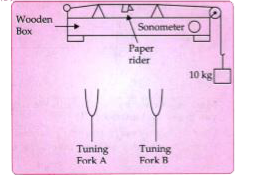A vibrating tuning fork, held over an air column of a given length with its one end closed, produces a loud audible sound. Name the phenomenon responsible for it and explain the observation.
Step-by-Step Solution:
1. Identify the Setup: We have a vibrating tuning fork placed over an air column that is closed at one end. This setup is crucial for understanding the sound produced.
2. Understand the Behavior of the Air Column: In this scenario, the air column behaves as a tube with one end closed. The closed end acts as a displacement node (where there is minimal movement of air particles) and the open end acts as a pressure antinode (where there is maximum movement of air particles).
3. Harmonics in a Closed Tube: For a tube that is closed at one end, it supports only odd harmonics. This means that the fundamental frequency (1st harmonic) and the 3rd, 5th, etc., harmonics can resonate within the air column.
4. Resonance Phenomenon: The phenomenon responsible for the loud sound produced is called resonance. When the frequency of the vibrating tuning fork matches the natural frequency of the air column, resonance occurs.
5. Audibility of the Sound: The audible range of sound is typically between 20 Hz to 20 kHz. If the frequency of the tuning fork (which is producing the sound) falls within this range and matches the frequency of the air column, a loud sound is produced.
6. Forced Vibrations: The vibrating tuning fork causes forced vibrations in the air column. When the frequency of these forced vibrations matches the resonant frequency of the air column, we hear a loud sound.
7. Conclusion: Therefore, the phenomenon responsible for the loud audible sound produced by the vibrating tuning fork over the air column is resonance, which occurs when the frequencies match.
---
Topper's Solved these Questions
- SOUNDBook:ICSEChapter:SOUNDExercise:EXERCISE -7(B)( MULTIPLE CHOICE TYPE)
Explore 2 Videos
- SOUNDBook:ICSEChapter:SOUNDExercise:EXERCISE -7(C )
Explore 47 Videos
- SOUNDBook:ICSEChapter:SOUNDExercise:EXERCISE -7(A) (NUMERICALS )
Explore 14 Videos
- SIMPLE MACHINES Book:ICSEChapter:SIMPLE MACHINES Exercise:DIAGRAM BASED MCQ
Explore 5 Videos
- SPECIMEN PAPER (SOLVED)Book:ICSEChapter:SPECIMEN PAPER (SOLVED)Exercise:SECTION II
Explore 78 Videos
Similar Questions
A vibrating tuning fork is placed over the mouth of a burette filled with water. The tap is opened and the water level gradually falls.
What do you observe ? Name the phenomenon. When does it happen?
View SolutionA sonometer wire under tension of 63 N vibrating in its fundamental mode is in resonance with a vibrating tuning fork. The vibrating portion of that sonometer wire has a length of 10 cm and a mass of 1 g. The vibrating tuning fork is now moved away from the vibrating wire with a constant speed and an observer standing near the sonometer hears one beat per second. Calculate the speed with which the tuning fork is moved if the speed of sound in air is 300 m/s.
View SolutionA sonometer wire under tension of 64 N vibrating in its fundamental mode is in resonance with a vibrating tuning fork. The vibrating portion of the sonometer wire has a length of 10 cm and mass of 1 g. The vibrating tuning fork is now moved away from the vibrating wire with a constant speed and an observer standing near the sonometer hears one beat per second. Calculate the speed with which the tuning fork is moved, if the speed of sound in air is 300 m/s.
View Solution
The diagram above shows a wire stretched over a sonometer. Stems of two vibrating tuning forks A and B are touched to the wooden box of the sonometer. It is observed that the paper rider (a small piece of paper folded at the centre) present on the wire flies off when the stem of vibrating tuning fork B is touched to the wooden box but the paper just vibrates when the stem of vibrating tuning fork A is touched to the wooden box.
Name the phenomenon when the paper rider flies off.
View SolutionA vibrating tuning fork is placed over the mouth of a burette filled with water. The tap of the burette is opened and the water level gradually starts falling. It is found that the sound from the tuning fork becomes very loud for a particular length of the water column.
Name the phenomenon taking place when this happens.
View SolutionA vibrating tuning fork is placed over the mouth of a burette filled with water. The tap of the burette is opened and the water level gradually starts falling. It is found that the sound from the tuning fork becomes very loud for a particular length of the water column.
Why does the sound become very loud for this lenght of the water column?
View SolutionThe stem of a vibrating tuning fork is pressed against a table top.
Will it produce an audible sound ?
View SolutionA closed air column 32cm long is in resonance with a tuning fork . Another open air column of length 66cm is in resonance with another tuning fork . If the two forks produce 8beats/s when sounded together , find
the speed of sound in the air
View SolutionIf the velocity of sound in air is 336 m/s. The maximum length of a closed pipe that would produce a just audible sound will be
View SolutionThe diagram below shows a wire stretched over a sonometer. Stems of two vibrating tuning forks A and B are touched in turn to the wooden box of the sonometer. It is observed that the paper rider (a small piece of paper folded at the centre) present on the wire flies off when the stem of vibrating tuning fork B is touched to the wooden box but the paper just vibrates when the stem of vibrating tuning fork A is touched to the wooden box.

Name the phenomenon when the paper rider just vibrates.
View Solution
